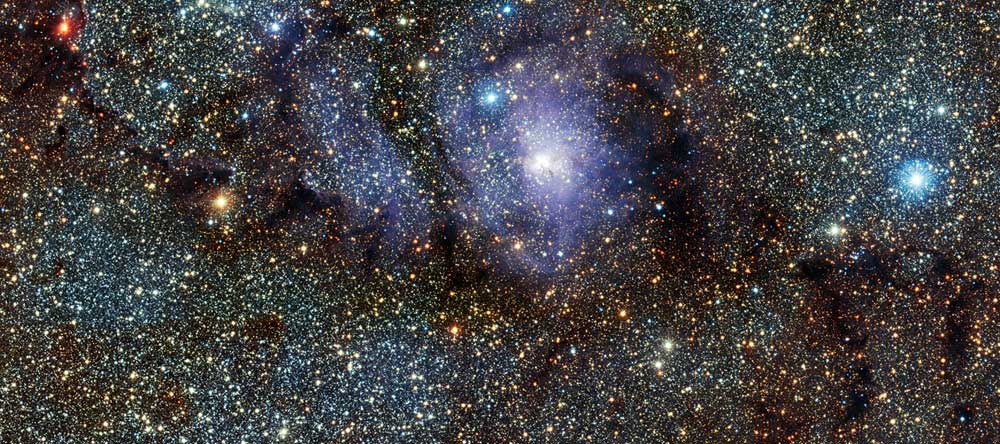Lagoon Nebula's Stellar Baby Boom Seen in New Photo

A gorgeous new image from the European Southern Observatory reveals the glowing, blue Lagoon Nebula – a hotbed of star birth – amid a backdrop speckled with bright stars.
The seemingly mystical Lagoon Nebula is a budding star nursery also known as Messier 8. It is approximately 4,000 to 5,000 light-years from Earth in the constellation of Sagittarius (the Archer).
The new infrared view of the nebula was captured as part of a five-year study of our Milky Way galaxy using ESO's Visible and Infrared Survey Telescope for Astronomy (VISTA) at the Paranal Observatory in Chile. The photo is just a small portion of a much larger image, and a wider survey, of the region surrounding the nebula.
Mapping the universe
Astronomers are using the VISTA telescope to scour our galaxy's central regions for new variable objects. The survey is also aimed at mapping the Milky Way's structure in greater detail than ever before.
Observations in the infrared wavelength can be a boon for astronomers because they are able to peer behind the veil of dust that would normally prevent celestial objects from being seen in visible light. This is because visible light, which has a wavelength that is roughly the same size as the dust particles, is strongly scattered.
Infrared light, on the other hand, has a longer wavelength and can pass through the dust largely unscathed.
Breaking space news, the latest updates on rocket launches, skywatching events and more!
ESO's VISTA telescope is dedicated to performing quick and deep scans over large areas of the sky at near-infrared wavelengths. With a 4.1-meter diameter mirror, it is the largest survey telescope in the world, and is ideally suited to studying star birth.
A cosmic lagoon
Stars typically form in large molecular clouds of gas and dust, which eventually collapse under their own weight. The Lagoon Nebula, however, has some additional features. This nursery is also home to a number of much more compact regions of collapsing gas and dust, known as Bok globules.
These regions are named after Bart Bok, a Dutch-American astronomer who first noticed the dark spots in regions of star formation. Bok speculated that they may be associated with the earliest stages of star formation, but hidden baby stars were only directly observed several decades later with the invention of infrared imaging.
Bok globules are so dense that, even in the infrared, they can sometimes block the starlight coming from background stars.
Still, the most famous dark feature in the Lagoon Nebula is the one for which it received its name – a lagoon-shaped dust lane that winds its way through the glowing cloud of gas.
The bright glow of the nebula is caused by the intense ultraviolet light from hot, young stars. But, the Lagoon Nebula is also home to stars much earlier in their stellar infancy – so young that they are still surrounded by their natal accretion disks.
These newborn stars occasionally emit jets of matter from their poles. When this ejected material ploughs into the surrounding gas, bright but short-lived streaks are formed. These features, called Herbig-Haro objects, make the newborn stars easy to spot.
In the last five years, several Herbig-Haro objects have been detected in the Lagoon Nebula, signifying the baby boom is still very much in full swing.
• Gallery: Cosmic Photos From the Paranal Observatory
• Birth of 'Impossible' Star Seen by European Space Telescope

Space.com is the premier source of space exploration, innovation and astronomy news, chronicling (and celebrating) humanity's ongoing expansion across the final frontier. Originally founded in 1999, Space.com is, and always has been, the passion of writers and editors who are space fans and also trained journalists. Our current news team consists of Editor-in-Chief Tariq Malik; Editor Hanneke Weitering, Senior Space Writer Mike Wall; Senior Writer Meghan Bartels; Senior Writer Chelsea Gohd, Senior Writer Tereza Pultarova and Staff Writer Alexander Cox, focusing on e-commerce. Senior Producer Steve Spaleta oversees our space videos, with Diana Whitcroft as our Social Media Editor.

